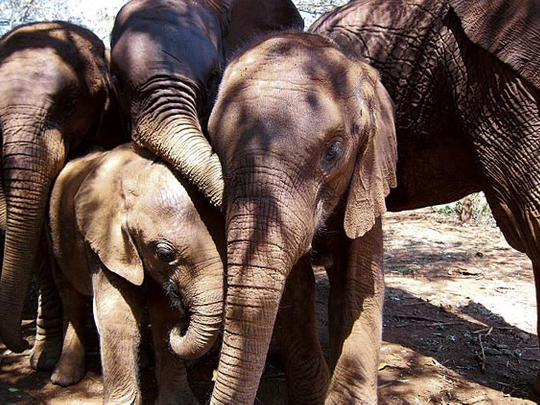
As I desperately tried to keep up along the dried mud pathway, excitement mounting, my shoulders brushing against the low hanging branches in Nairobi National Park, I enquired about the size of the elephant infants’ pens. “There is no fencing,” responded the keeper, Emilio. “The elephants are free to roam the entire park.” Alarm bells ringing, I stammered, “but… but… there are 40 lions on the loose in here.” Chuckling, he replied, “Yes, so you’d better be prepared to run!”
Emilio’s warm and fearless response is a signature trait echoed by the 52 keepers dedicating their lives to orphaned elephants at this David Sheldrick Wildlife Trust nursery. This small sanctuary nestled against the backdrop of acacia trees, plains, forests and savannah landscapes is a haven of love and comfort for the young, left orphaned primarily at the hands of poachers. Here, under the supervision of one of the most trusted global authorities on elephant rehabilitation, Dr Dame Daphne Sheldrick, calves are hand-reared to return to the wild.
In 1987 Sheldrick became the first person to raise a newborn orphaned African elephant. Since then, 140 infants have been successfully reared and returned to the wild. Such a feat has not come effortlessly; Sheldrick has committed 28 years to understanding elephant husbandry, formulating milk acceptable to an elephant’s digestion and emulating an orphan’s natural habitat. At the nursery the trusts’ dedicated keepers work around the clock putting years of research into practice.
Nurturing practices
The David Sheldrick Wildlife Trust’s nursery is a home for orphans until the age of three or until they are no longer milk-dependent. Here the infants receive not only the physical care needed to nurse them back to the wild, but the same love and attention they would receive from their mothers.
Baby elephants require feeding every three hours and the keepers’ duties extend to sharing a stable with the delicate young overnight. Bunk beds are erected above a straw-carpeted floor and through the night the orphans are fed with a milk, porridge and coconut mix fortified with vitamins. Throughout the day the babies, who no longer have access to the natural shelter of their mothers, are protected from the elements by their human family. Sheldrick keepers cover the little elephants with blankets to stabilise their temperatures, put sunblock on their ears and backs to prevent sunstroke and, in the rainy season, cover them with custom-made orange waterproofs to defend them against pneumonia.
Like humans, elephants are dramatically affected by violence. Witnessing the murder of their loved ones at the hands of poachers can lead to an array of health complications including post-traumatic stress. At the nursery a lot of emphasis is therefore placed on helping them overcome shock and grief, primarily by quickly replacing their lost herd with a human family.
Reaping rewards
Keepers work on a rotation basis, never allowing the little one to grow too close to one particular person. As Sheldrick explains, “that’s a mistake I made in the beginning because it was just me, I didn’t have a team of keepers – and when I had to leave a little elephant in the care of a friend, she thought she had lost another mother and died of a broken heart.”
The obvious happiness of the infant orphans at the David Sheldrick Wildlife Trust’s nursery and the success rate at which they are reared is testament to the care and love the trust showers on these once desolate elephants.
The appreciation from an animal that never forgets is best demonstrated by the actions of those orphans now back in the wild. It has been said that from time to time the elephants return to visit their keepers with a special tribute: Their own baby elephant, born and raised wild and free. Quite an accolade.












